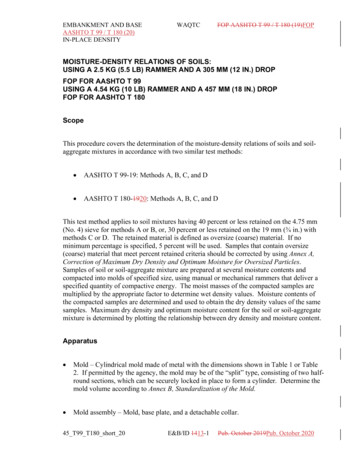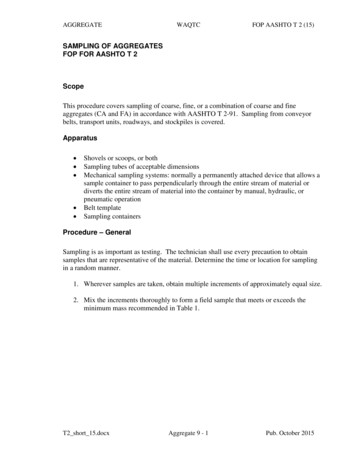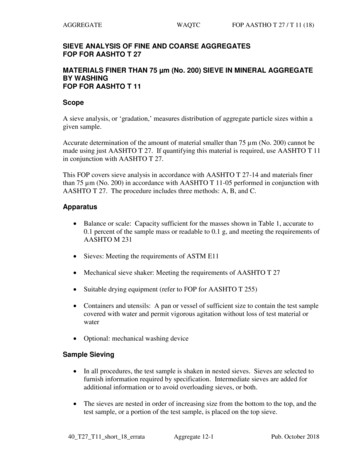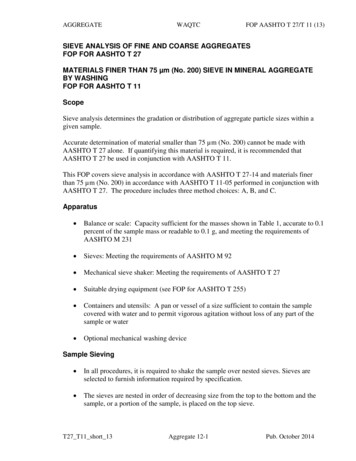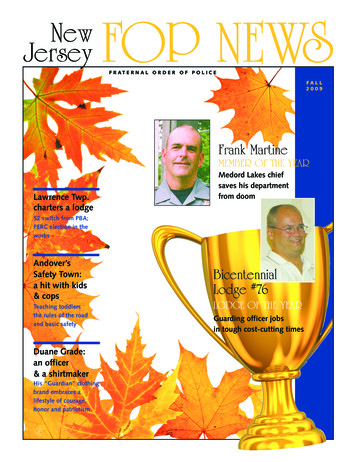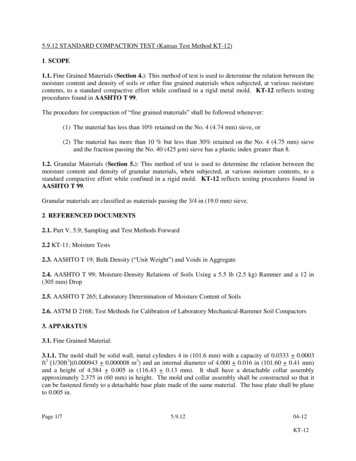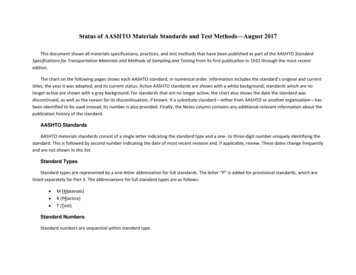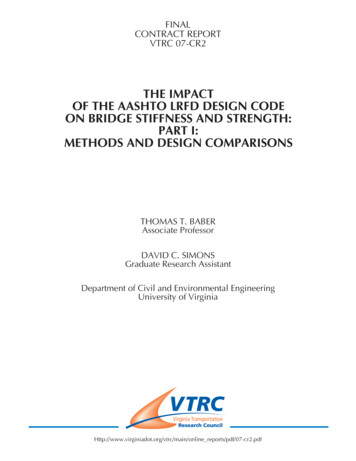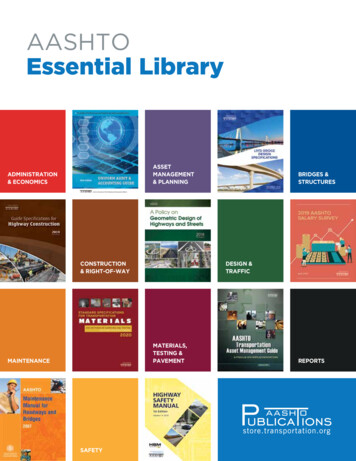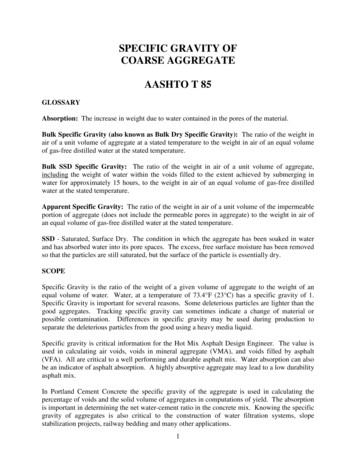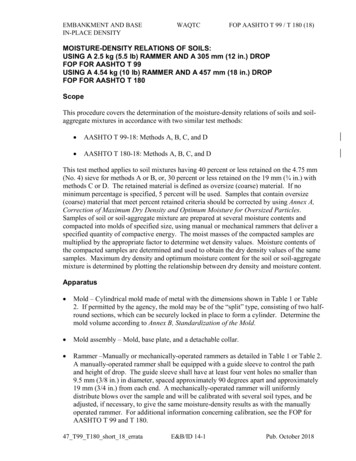
Transcription
EMBANKMENT AND BASEIN-PLACE DENSITYWAQTCFOP AASHTO T 99 / T 180 (18)MOISTURE-DENSITY RELATIONS OF SOILS:USING A 2.5 kg (5.5 lb) RAMMER AND A 305 mm (12 in.) DROPFOP FOR AASHTO T 99USING A 4.54 kg (10 lb) RAMMER AND A 457 mm (18 in.) DROPFOP FOR AASHTO T 180ScopeThis procedure covers the determination of the moisture-density relations of soils and soilaggregate mixtures in accordance with two similar test methods: AASHTO T 99-18: Methods A, B, C, and D AASHTO T 180-18: Methods A, B, C, and DThis test method applies to soil mixtures having 40 percent or less retained on the 4.75 mm(No. 4) sieve for methods A or B, or, 30 percent or less retained on the 19 mm (¾ in.) withmethods C or D. The retained material is defined as oversize (coarse) material. If nominimum percentage is specified, 5 percent will be used. Samples that contain oversize(coarse) material that meet percent retained criteria should be corrected by using Annex A,Correction of Maximum Dry Density and Optimum Moisture for Oversized Particles.Samples of soil or soil-aggregate mixture are prepared at several moisture contents andcompacted into molds of specified size, using manual or mechanical rammers that deliver aspecified quantity of compactive energy. The moist masses of the compacted samples aremultiplied by the appropriate factor to determine wet density values. Moisture contents ofthe compacted samples are determined and used to obtain the dry density values of the samesamples. Maximum dry density and optimum moisture content for the soil or soil-aggregatemixture is determined by plotting the relationship between dry density and moisture content.Apparatus Mold – Cylindrical mold made of metal with the dimensions shown in Table 1 or Table2. If permitted by the agency, the mold may be of the “split” type, consisting of two halfround sections, which can be securely locked in place to form a cylinder. Determine themold volume according to Annex B, Standardization of the Mold. Mold assembly – Mold, base plate, and a detachable collar. Rammer –Manually or mechanically-operated rammers as detailed in Table 1 or Table 2.A manually-operated rammer shall be equipped with a guide sleeve to control the pathand height of drop. The guide sleeve shall have at least four vent holes no smaller than9.5 mm (3/8 in.) in diameter, spaced approximately 90 degrees apart and approximately19 mm (3/4 in.) from each end. A mechanically-operated rammer will uniformlydistribute blows over the sample and will be calibrated with several soil types, and beadjusted, if necessary, to give the same moisture-density results as with the manuallyoperated rammer. For additional information concerning calibration, see the FOP forAASHTO T 99 and T 180.47 T99 T180 short 18 errataE&B/ID 14-1Pub. October 2018
EMBANKMENT AND BASEIN-PLACE DENSITYWAQTCFOP AASHTO T 99 / T 180 (18) Sample extruder – A jack, lever frame, or other device for extruding compactedspecimens from the mold quickly and with little disturbance. Balance(s) or scale(s) of the capacity and sensitivity required for the procedure used bythe agency.A balance or scale with a capacity of 11.5 kg (25 lb) and a sensitivity of 1 gfor obtaining the sample, meeting the requirements of AASHTO M 231,Class G 5.A balance or scale with a capacity of 2 kg and a sensitivity of 0.1 g is used formoisture content determinations done under both procedures, meeting therequirements of AASHTO M 231, Class G 2. Drying apparatus – A thermostatically controlled drying oven, capable of maintaining atemperature of 110 5 C (230 9 F) for drying moisture content samples in accordancewith the FOP for AASHTO T 255/T 265. Straightedge – A steel straightedge at least 250 mm (10 in.) long, with one beveled edgeand at least one surface plane within 0.1 percent of its length, used for final trimming. Sieve(s) – 4.75 mm (No. 4) and/or 19.0 mm (3/4 in.), meeting the requirements of FOPfor AASHTO T 27/T 11. Mixing tools – Miscellaneous tools such as a mixing pan, spoon, trowel, spatula, etc., or asuitable mechanical device, for mixing the sample with water. Containers with close-fitting lids to prevent gain or loss of moisture in the sample.47 T99 T180 short 18 errataE&B/ID 14-2Pub. October 2018
EMBANKMENT AND BASEIN-PLACE DENSITYWAQTCFOP AASHTO T 99 / T 180 (18)Table 1Comparison of Apparatus, Sample, and Procedure – MetricMold Volume, m3Mold Diameter, mmMold Height, mmDetachable Collar Height, mmRammer Diameter, mmRammer Mass, kgRammer Drop, mmLayersBlows per LayerMaterial Size, mmTest Sample Size, kgT 99Methods A, C: 0.000943 0.000014Methods B, D: 0.002124 0.000025Methods A, C: 101.60 0.40Methods B, D: 152.40 0.70116.40 0.5050.80 0.6450.80 0.252.495 0.0093053Methods A, C: 25Methods B, D: 56Methods A, B: 4.75 minusMethods C, D: 19.0 minusMethod A: 3Method C: 5 (1)T 180Methods A, C: 0.000943 0.000014Methods B, D: 0.002124 0.000025Methods A, C: 101.60 0.4Methods B, D: 152.40 0.70116.40 0.5050.80 0.6450.80 0.254.536 0.0094575Methods A, C: 25Methods B, D: 56Methods A, B: 4.75 minusMethods C, D: 19.0 minusMethod B: 7Method D: 11(1)Energy, kN-m/m35922,693(1) This may not be a large enough sample depending on your nominal maximum size for moisture contentsamples.Table 2Comparison of Apparatus, Sample, and Procedure – EnglishMold Volume, ft3Mold Diameter, in.Mold Height, in.Detachable Collar Height, in.Rammer Diameter, in.Rammer Mass, lbRammer Drop, in.LayersBlows per LayerMaterial Size, in.Test Sample Size, lbT 99Methods A, C: 0.0333 0.0005Methods B, D: 0.07500 0.0009Methods A, C: 4.000 0.016Methods B, D: 6.000 0.0264.584 0.0182.000 0.0252.000 0.0255.5 0.02123Methods A, C: 25Methods B, D: 56Methods A, B: No. 4 minusMethods C, D: 3/4 minusMethod A: 7Method C: 12(1)T 180Methods A, C: 0.0333 0.0005Methods B, D: 0.07500 0.0009Methods A, C: 4.000 0.016Methods B, D: 6.000 0.0264.584 0.0182.000 0.0252.000 0.02510 0.02185Methods A, C: 25Methods B, D: 56Methods A, B: No.4 minusMethods C, D: 3/4 minusMethod B: 16Method D: 25(1)Energy, lb-ft/ft312,37556,250(1) This may not be a large enough sample depending on your nominal maximum size for moisture contentsamples.47 T99 T180 short 18 errataE&B/ID 14-3Pub. October 2018
EMBANKMENT AND BASEIN-PLACE DENSITYWAQTCFOP AASHTO T 99 / T 180 (18)SampleIf the sample is damp, dry it until it becomes friable under a trowel. Drying may be in air orby use of a drying apparatus maintained at a temperature not exceeding 60 C (140 F).Thoroughly break up aggregations in a manner that avoids reducing the natural size ofindividual particles.Obtain a representative test sample of the mass required by the agency by passing thematerial through the sieve required by the agency. See Table 1 or Table 2 for test samplemass and material size requirements.In instances where the material is prone to degradation, i.e., granular material, a compactionsample with differing moisture contents should be prepared for each point.If the sample is plastic (clay types), it should stand for a minimum of 12 hours after theaddition of water to allow the moisture to be absorbed. In this case, several samples atdifferent moisture contents should be prepared, put in sealed containers and tested the nextday.Note 1: Both T 99 and T 180 have four methods (A, B, C, D) that require different masses and employdifferent sieves.ProcedureDuring compaction, rest the mold firmly on a dense, uniform, rigid, and stable foundation orbase. This base shall remain stationary during the compaction process.1. Determine the mass of the clean, dry mold. Include the base plate, but exclude theextension collar. Record the mass to the nearest 1 g (0.005 lb).2. Thoroughly mix the selected representative sample with sufficient water to dampen it toapproximately 4 to 8 percentage points below optimum moisture content. For manymaterials, this condition can be identified by forming a cast by hand.a. Prepare individual samples of plastic or degradable material, increasing moisturecontents 1 to 2 percent for each point.b. Allow samples of plastic soil to stand for 12 hrs.3. Form a specimen by compacting the prepared soil in the mold assembly in approximatelyequal layers. For each layer:a. Spread the loose material uniformly in the mold.Note 2: It is recommended to cover the remaining material with a non-absorbent sheet or damp cloth tominimize loss of moisture.b. Lightly tamp the loose material with the manual rammer or other similar device, thisestablishes a firm surface.47 T99 T180 short 18 errataE&B/ID 14-4Pub. October 2018
EMBANKMENT AND BASEIN-PLACE DENSITYWAQTCFOP AASHTO T 99 / T 180 (18)c. Compact each layer with uniformly distributed blows from the rammer. See Table 1for mold size, number of layers, number of blows, and rammer specification for thevarious test methods. Use the method specified by the agency.d. Trim down material that has not been compacted and remains adjacent to the walls ofthe mold and extends above the compacted surface.4. Remove the extension collar. Avoid shearing off the sample below the top of the mold.The material compacted in the mold should not be over 6 mm(¼ in.) above the top of the mold once the collar has been removed.5. Trim the compacted soil even with the top of the mold with the beveled side of thestraightedge.6. Clean soil from exterior of the mold and base plate.7. Determine and record the mass of the mold, base plate, and wet soil to the nearest 1 g(0.005 lb) or better.8. Determine and record the wet mass (Mw) of the sample by subtracting the mass in Step 1from the mass in Step 6.9. Calculate the wet density, in kg/m3 (lb/ft3), by dividing the wet mass by the measuredvolume (Vm).10. Extrude the material from the mold. For soils and soil-aggregate mixtures, slice verticallythrough the center and take a representative moisture content sample from one of the cutfaces, ensuring that all layers are represented. For granular materials, a vertical face willnot exist. Take a representative sample. This sample must meet the sample sizerequirements of the test method used to determine moisture content.Extruded materialRepresentative moisturecontent sampleNote 3: When developing a curve for free-draining soils such as uniform sands and gravels, where seepageoccurs at the bottom of the mold and base plate, taking a representative moisture content from the mixingbowl may be preferred in order to determine the amount of moisture available for compaction.47 T99 T180 short 18 errataE&B/ID 14-5Pub. October 2018
EMBANKMENT AND BASEIN-PLACE DENSITYWAQTCFOP AASHTO T 99 / T 180 (18)11. Determine and record the moisture content of the sample in accordance with the FOP forAASHTO T 255 / T 265.12. If the material is degradable or plastic, return to Step 3 using a prepared individualsample. If not, continue with Steps 13 through 15.13. Thoroughly break up the remaining portion of the molded specimen until it will againpass through the sieve, as judged by eye, and add to the remaining portion of the samplebeing tested.14. Add sufficient water to increase the moisture content of the remaining soil by 1 to 2percentage points and repeat steps 3 through 11.15. Continue determinations until there is either a decrease or no change in the wet mass.There will be a minimum of three points on the dry side of the curve and two points onthe wet side. For non-cohesive, drainable soils, one point on the wet side is sufficient.CalculationsWet Density𝐷𝐷𝑤𝑤 Where:𝑀𝑀𝑤𝑤𝑉𝑉𝑚𝑚Dw wet density, kg/m3 (lb/ft3)Mw wet massVm volume of the mold, Annex B47 T99 T180 short 18 errataE&B/ID 14-6Pub. October 2018
EMBANKMENT AND BASEIN-PLACE DENSITYWAQTCFOP AASHTO T 99 / T 180 (18)Dry Density𝐷𝐷𝑤𝑤𝐷𝐷𝑑𝑑 100𝑤𝑤 100𝑜𝑜𝑜𝑜 𝐷𝐷𝑑𝑑 Where:𝐷𝐷𝑤𝑤𝑤𝑤 100 1Dd dry density, kg/m3 (lb/ft3)w moisture content, as a percentageExample for 4-inch mold, Methods A or CWet mass, Mw 1.928 kg (4.25 lb)Moisture content, w 11.3%Measured volume of the mold, Vm 0.000946 m3 (0.0334 ft3)Wet Density𝐷𝐷𝑤𝑤 1.928 𝑘𝑘𝑘𝑘4.25 𝑙𝑙𝑙𝑙3 2038𝑘𝑘𝑘𝑘𝑚𝑚𝐷𝐷 127.2 𝑙𝑙𝑙𝑙 𝑓𝑓𝑓𝑓 3𝑤𝑤0.000946 𝑚𝑚30.0334 𝑓𝑓𝑓𝑓 3Dry Density𝐷𝐷𝑑𝑑 2038 𝑘𝑘𝑘𝑘 𝑚𝑚3127.2 𝑙𝑙𝑙𝑙 𝑓𝑓𝑓𝑓 3 100 1831 𝑘𝑘𝑘𝑘 𝑚𝑚3 𝐷𝐷𝑑𝑑 100 114.3 𝑙𝑙𝑙𝑙 𝑓𝑓𝑓𝑓 311.3 10011.3 100Or2038 𝑘𝑘𝑘𝑘 𝑚𝑚3127.2 𝑙𝑙𝑙𝑙 𝑓𝑓𝑓𝑓 3𝐷𝐷𝑑𝑑 1831 𝑘𝑘𝑘𝑘 𝑚𝑚3 𝐷𝐷𝑑𝑑 114.3 𝑙𝑙𝑙𝑙 𝑓𝑓𝑓𝑓 311.311.3100 1100 147 T99 T180 short 18 errataE&B/ID 14-7Pub. October 2018
EMBANKMENT AND BASEIN-PLACE DENSITYWAQTCFOP AASHTO T 99 / T 180 (18)Moisture-Density Curve DevelopmentWhen dry density is plotted on the vertical axis versus moisture content on the horizontalaxis and the points are connected with a smooth line, a moisture-density curve is developed.The coordinates of the peak of the curve are the maximum dry density, or just “maximumdensity,” and the “optimum moisture content” of the soil.ExampleGiven the following dry density and corresponding moisture content values develop amoisture-density relations curve and determine maximum dry density and optimum moisturecontent.Dry 16.71857115.9Moisture Content, %11.312.112.813.614.2x1900x118.0Maximum Dry Density 1880 kg/m 3 (117.3 lbs/ft3)Optimum Moisture 13.2%xDry Density lb/ft3xx116.01860xDry Density kg/m31880x117.0115.01860x114.01820x113.010 %11 %47 T99 T180 short 18 errata12 %13 %Moisture Content (%)E&B/ID 14-814 %15 %16 %Pub. October 2018
EMBANKMENT AND BASEIN-PLACE DENSITYWAQTCFOP AASHTO T 99 / T 180 (18)In this case, the curve has its peak at:Maximum dry density 1880 kg/m3 (117.3 lb/ft3)Optimum moisture content 13.2%Note that both values are approximate, since they are based on sketching the curve to fit thepoints.Report Results on forms approved by the agency Sample ID Maximum dry density to the closest 1 kg/m3 (0.1 lb/ft3) Optimum moisture content to the closest 0.1 percent47 T99 T180 short 18 errataE&B/ID 14-9Pub. October 2018
EMBANKMENT AND BASEIN-PLACE DENSITYWAQTCFOP AASHTO T 99 / T 180 (18)ANNEX ACORRECTION OF MAXIMUM DRY DENSITY AND OPTIMUM MOISTURE FOROVERSIZED PARTICLESThis s
embankment and base waqtc fop aashto t 99 / t 180 (18) in-place density . 47_t99_t180_short_18_errata e&b/id 14-1 pub. october 2018 . moisture-density relations of soils: using a 2.5 kg (5.5 lb) rammer and a 305 mm (12 in.) drop . fop for aashto t 99 using a 4.54 kg (10 lb) rammer and a 457 mm (18 in.) drop fop for aashto t 180 scopeFile Size: 392KBPage Count: 18
